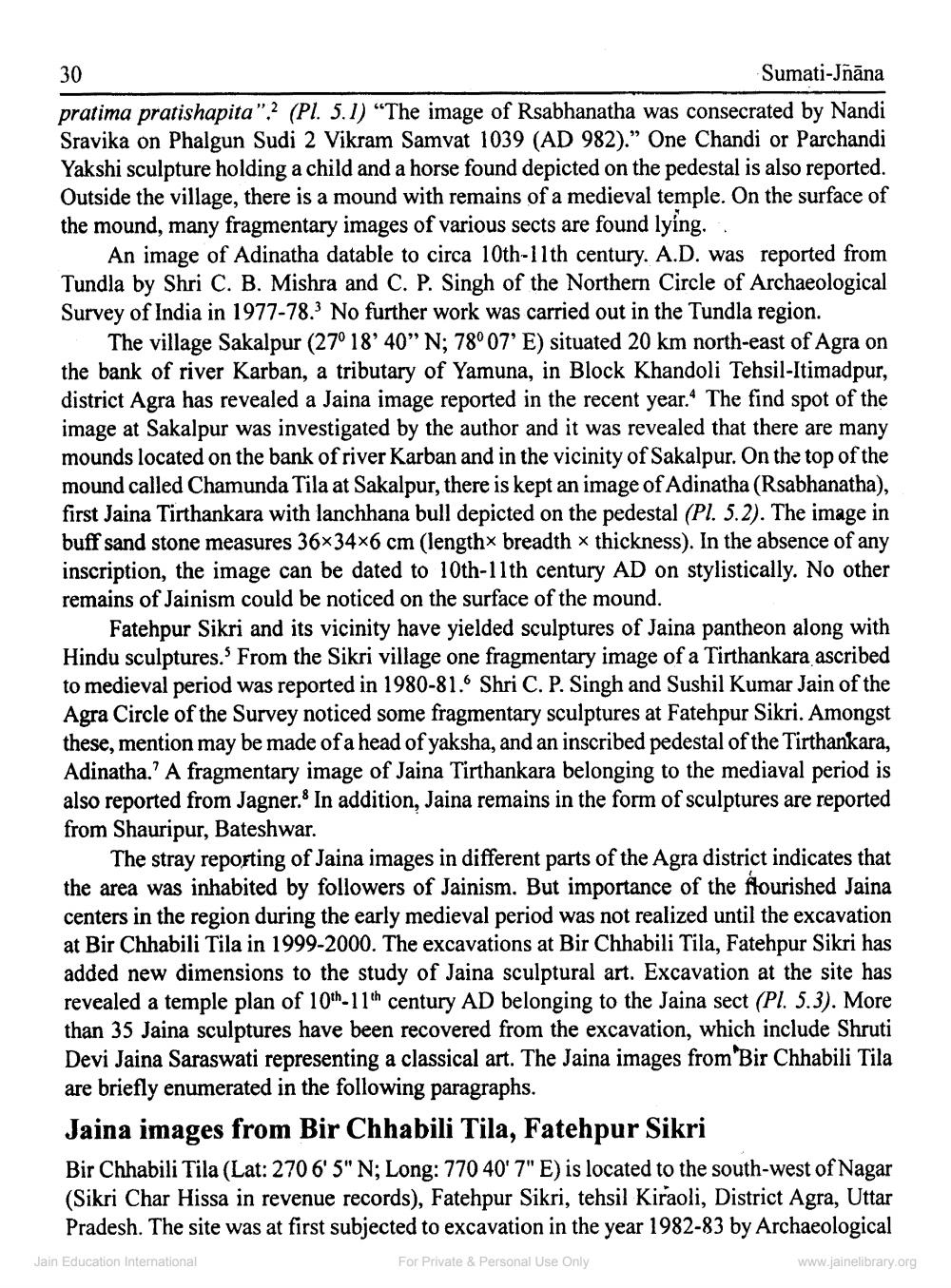________________
30
Sumati-Jnāna pratima pratishapita"? (Pl. 5.1) “The image of Rsabhanatha was consecrated by Nandi Sravika on Phalgun Sudi 2 Vikram Samvat 1039 (AD 982).” One Chandi or Parchandi Yakshi sculpture holding a child and a horse found depicted on the pedestal is also reported. Outside the village, there is a mound with remains of a medieval temple. On the surface of the mound, many fragmentary images of various sects are found lying.
An image of Adinatha datable to circa 10th-11th century. A.D. was reported from Tundla by Shri C. B. Mishra and C. P. Singh of the Northern Circle of Archaeological Survey of India in 1977-78. No further work was carried out in the Tundla region
The village Sakalpur (27° 18' 40" N; 78° 07' E) situated 20 km north-east of Agra on the bank of river Karban, a tributary of Yamuna, in Block Khandoli Tehsil-Itimadpur, district Agra has revealed a Jaina image reported in the recent year." The find spot of the image at Sakalpur was investigated by the author and it was revealed that there are many mounds located on the bank of river Karban and in the vicinity of Sakalpur. On the top of the mound called Chamunda Tila at Sakalpur, there is kept an image of Adinatha (Rsabhanatha), first Jaina Tirthankara with lanchhana bull depicted on the pedestal (Pl. 5.2). The image in buff sand stone measures 36*34x6 cm (length breadth thickness). In the absence of any inscription, the image can be dated to 10th-11th century AD on stylistically. No ot remains of Jainism could be noticed on the surface of the mound.
Fatehpur Sikri and its vicinity have yielded sculptures of Jaina pantheon along with Hindu sculptures. From the Sikri village one fragmentary image of a Tirthankara ascribed to medieval period was reported in 1980-81. Shri C. P. Singh and Sushil Kumar Jain of the Agra Circle of the Survey noticed some fragmentary sculptures at Fatehpur Sikri. Amongst these, mention may be made of a head of yaksha, and an inscribed pedestal of the Tirthankara, Adinatha.? A fragmentary image of Jaina Tirthankara belonging to the mediaval period is also reported from Jagner. In addition, Jaina remains in the form of sculptures are reported from Shauripur, Bateshwar.
The stray reporting of Jaina images in different parts of the Agra district indicates that the area was inhabited by followers of Jainism. But importance of the flourished Jaina centers in the region during the early medieval period was not realized until the excavation at Bir Chhabili Tila in 1999-2000. The excavations at Bir Chhabili Tila, Fatehpur Sikri has added new dimensions to the study of Jaina sculptural art. Excavation at the site has revealed a temple plan of 10th 11th century AD belonging to the Jaina sect (Pl. 5.3). More than 35 Jaina sculptures have been recovered from the excavation, which include Shruti Devi Jaina Saraswati representing a classical art. The Jaina images from Bir Chhabili Tila are briefly enumerated in the following paragraphs. Jaina images from Bir Chhabili Tila, Fatehpur Sikri Bir Chhabili Tila (Lat:2706'5"N; Long: 770 40' 7"E) is located to the south-west of Nagar (Sikri Char Hissa in revenue records), Fatehpur Sikri, tehsil Kiraoli, District Agra, Uttar Pradesh. The site was at first subjected to excavation in the year 1982-83 by Archaeological
Jain Education International
For Private & Personal Use Only
www.jainelibrary.org




